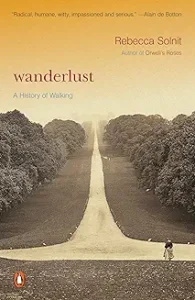Wanderlust: A History of Walking by Rebecca Solnit 2000
Solnit is one of our most incisive and insightful cultural and literary critics. A feminist and a strong supporter of civil rights and income and resource equity, she tackles a history of something that most people do without thinking—walking.
Since Homo sapiens descended from the trees in East Africa and began to walk upright in the savannah some 3 million years or so ago, we’ve been walking, an altogether awkward and on its surface, somewhat comical and impossible act. Balanced on our two feet, we take one off the ground, swing it forward landing on the heel and then the toe, and lurch ahead in order to avoid falling and to take the next step. Strange as it might seem, upright walking has apparently led to the development of the large human brain and enabled us to use our hands to make tools, write words, and fashion things like the Pyramids and the Eiffel Tower.
In this long and at times too detailed look at walking, Solnit explores the unique relationship that walking affords between the body, the mind, and the environment. As she states in the Introduction: “Exploring the world is one of the best ways of exploring the mind, and walking travels both terrains.”
Taking a deep dive she explores the history and leading personalities of thinkers and writers who depended on walking for their inspirations and ideas: philosophers such as Rousseau and Kierkegaard, poets such as Wordsworth, Coleridge, writers such as Jane Austen and Viriginia Woolf, artists whose subject matter was walking itself such as my own Richard Long and Hamish Fulton, pilgrimmages and Buddhist walking meditation, mountaineering and hiking practitioners like John Muir and the poet , Gary Snyder, the urban walking flaneur exemplified by Baudelaire and Walter Benjamin, women walkers and streetwalkers, and walking clubs. She finishes the volume with blistering critiques of suburbia’s fragmentation and privitization and its epitome, Las Vegas and the modern gym with its treadmills and stairmasters, equipment designed to do the work that labor-saving devices has eliminated in the modern world.
This topic could have proven to be a bit dull and/or overwhelming, but Solnit is a fine writer who can turn her sharp eye into memorable language. Here’s her take on the popular uprisings in Eastern Europe in the late 1980’s: “Walking, which can be prayer, sex, communion with the land, or musing, becomes speech in these demonstrations and uprisings, and a lot of history has been written with the feet of citizens. “
I enjoyed this literate and spryly written account of the history of an activity that occupies a signficant part of my everyday life. When I had to give up my daily 5 mile run and the hope of running a fourth marathon, I turned to walking. I walk dirt roads and mountain bike and skimobile trails in Vermont and the banks of the Charles River’s and the urban landscape in Cambridge every day, averaging 4 miles/day for the last several years. Solnit’s distinction between these two environiments struck a familiar chord for me. Walking in Vermont is always about the landscape—the trees, wildflowers, mushrooms, glacial erratics, birdcalls, and the occasional deer or porcupine. Walking in Cambridge is all about the storefronts, the people, the rushing river of pedestrians. Here’s Solnit on walking in the city: “To me, the magic of the street is the mingling of the errand and the epiphany….” A perfect summary of walking in the city just as this book is a perfect companion for the walker, wherever the walk takes place.



